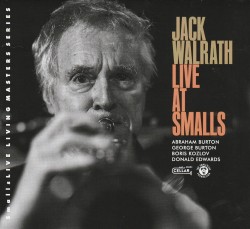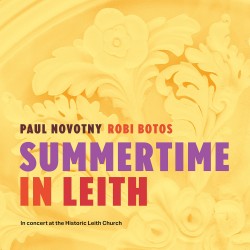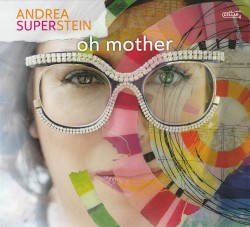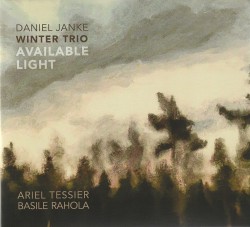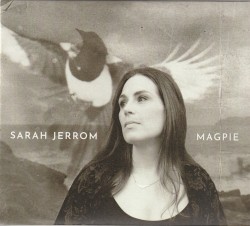Earlier this year, Canada’s newspaper of record, the Globe & Mail, took a full two weeks to publish a story on the death at 100 of Phil Nimmons, arguably Canada’s dean of modern jazz. Media priorities differ, although reporting on the demise of pop music performers seems to happen almost immediately, but in a way this reflects the perception of jazz as a young person’s art. That’s about as bogus as any other musical cliché, and right now there are numerous improvising musicians creating memorable sounds in their late 70s and 80s.
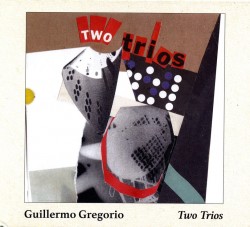 Take Argentinian-American clarinetist Guillermo Gregorio, 82 for instance. An academic dealing with architecture and art history, he played improvised music at the same time and has intensified his musical interests since he stopped teaching. Two Trios (ESP 5047 espdisk.com/5047) involves live sessions featuring the clarinetist with either cellist Fred Lonberg-Holm and vibraphonist Carrie Biolo or contralto clarinetist Iván Barenboim and cellist Nicholas Jozwiak. In sync chamber improv in both cases, the first finds the vibist alternating between front line shimmers and rhythmic thumps as Lonberg-Holm sharpens the program with string slices and stops while Gregorio elaborates themes with reed glissandi, flutters and chalumeau register lowing. Although most tracks are almost lyrical, with an emphasis on harmony, others like Degrees of Iconicity and Improvisation toughen the program with the equivalent of bell-ringing motifs from Biolo, sul ponticello emphasis from the cellist and Gregorio’s timbres fluctuating from andante to presto as he squeals split tones upwards. Even more energized, the second trio set uses contralto clarinet tones as a huffing ostinato mixed with string strums for bouncing expositions as Gregorio distills aggressive or pastoral trills from his horn, interjecting vibrations at many speeds. Still like the session with the other trio, a track like Out of the Other Notes is an interlude confirming that intense free music can also be well-balanced, moderated and linear.
Take Argentinian-American clarinetist Guillermo Gregorio, 82 for instance. An academic dealing with architecture and art history, he played improvised music at the same time and has intensified his musical interests since he stopped teaching. Two Trios (ESP 5047 espdisk.com/5047) involves live sessions featuring the clarinetist with either cellist Fred Lonberg-Holm and vibraphonist Carrie Biolo or contralto clarinetist Iván Barenboim and cellist Nicholas Jozwiak. In sync chamber improv in both cases, the first finds the vibist alternating between front line shimmers and rhythmic thumps as Lonberg-Holm sharpens the program with string slices and stops while Gregorio elaborates themes with reed glissandi, flutters and chalumeau register lowing. Although most tracks are almost lyrical, with an emphasis on harmony, others like Degrees of Iconicity and Improvisation toughen the program with the equivalent of bell-ringing motifs from Biolo, sul ponticello emphasis from the cellist and Gregorio’s timbres fluctuating from andante to presto as he squeals split tones upwards. Even more energized, the second trio set uses contralto clarinet tones as a huffing ostinato mixed with string strums for bouncing expositions as Gregorio distills aggressive or pastoral trills from his horn, interjecting vibrations at many speeds. Still like the session with the other trio, a track like Out of the Other Notes is an interlude confirming that intense free music can also be well-balanced, moderated and linear.
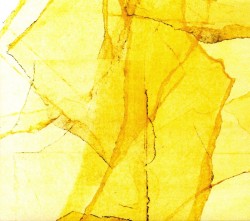 Full time musicians and early members of Chicago’s AACM, trumpeter Wadada Leo Smith and pianist/organist Amina Claudine Myers, both 82, combine to celebrate the grandeur of New York’s Central Park’s Mosaics of Reservoir, Lake, Paths and Gardens (Red Hook Records RH 1005 redhookrecords.com/rh1005). A seven-part suite, with six tracks composed by Smith and one by Myers, the mood throughout is moderate, unhurried and precise as well as discriminating in its depiction. With the pianist usually concentrating on quiet plinking and expressive cadenzas, the park’s spaciousness is reflected in Smith’s sophisticated storytelling. Squeezing out a tapestry of perfectly rounded notes, his portamento is pensive and passionate in equal measure. Jubilation is most obvious on a track like Central Park at Sunset when he spreads grace notes all over the exposition, with the subsequent descending tones cushioned by darkened soundboard rumbles and a hint of gospel piano. Myers’ composition When Was is initially recital-like formal, but loosens up with a profusion of curvaceous tones at elevated pitches and by the end is the closest to unmetered free music on the disc. Smith’s mournful didacticism isn’t just obvious on a brief track matching his Harmon-muted flutters with organ burbles attached to faint ecclesiastical suggestions, but at greater length on Albert Ayler, a meditation in light. Named for the late saxophonist who lived near Central Park’s northern boundary, Smith’s half-valve smears and slurs in this threnody turn to defiant yet graceful trills at the end. Beside him Myers’ thick chording likewise slides into gentleness by the conclusion.
Full time musicians and early members of Chicago’s AACM, trumpeter Wadada Leo Smith and pianist/organist Amina Claudine Myers, both 82, combine to celebrate the grandeur of New York’s Central Park’s Mosaics of Reservoir, Lake, Paths and Gardens (Red Hook Records RH 1005 redhookrecords.com/rh1005). A seven-part suite, with six tracks composed by Smith and one by Myers, the mood throughout is moderate, unhurried and precise as well as discriminating in its depiction. With the pianist usually concentrating on quiet plinking and expressive cadenzas, the park’s spaciousness is reflected in Smith’s sophisticated storytelling. Squeezing out a tapestry of perfectly rounded notes, his portamento is pensive and passionate in equal measure. Jubilation is most obvious on a track like Central Park at Sunset when he spreads grace notes all over the exposition, with the subsequent descending tones cushioned by darkened soundboard rumbles and a hint of gospel piano. Myers’ composition When Was is initially recital-like formal, but loosens up with a profusion of curvaceous tones at elevated pitches and by the end is the closest to unmetered free music on the disc. Smith’s mournful didacticism isn’t just obvious on a brief track matching his Harmon-muted flutters with organ burbles attached to faint ecclesiastical suggestions, but at greater length on Albert Ayler, a meditation in light. Named for the late saxophonist who lived near Central Park’s northern boundary, Smith’s half-valve smears and slurs in this threnody turn to defiant yet graceful trills at the end. Beside him Myers’ thick chording likewise slides into gentleness by the conclusion.
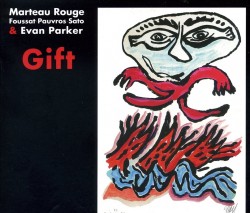 There was nothing gentle or melancholy about the live meeting between British saxophonist Evan Parker, 80, and members of the French Marteau Rouge trio on Gift (FOU Records FR-CD 51 fourecords.com/FR-CD51). A self-contained unit that boomerangs among tough improv, rock and electronics, guitarist Jean-François Pauvros, drummer Makoto Sato and synthesizer player Jean-Marc Foussat bring a furious energy to their playing. Finding a prominent place for himself among Pavros’ twangs, frail and arco string bowing expressions, Sato’s steady beat and Foussat’s processed drones and field recorded samples doesn’t faze the saxophonist who has faced down big bands and electric-acoustic ensembles with the same aplomb. He outputs what could be termed anthracite lyricism at points, his usual strategy, especially on Into The Deep, the more than 34-minute centrepiece. Building on earlier synthesized, organ-like thrusts, constant string strums and drum rumbles, Parker alternately soars over the interface with whistling timbral variations or snorts and snarls that whir as much as programmed voltage, as vibrating reed pressure finds a place beside the guitarist’s intense flanges and twangs. In contrast though, while the saxist fragments textures into slurps and split tones – the better to challenge Sato’s drum clunks and clips and Foussat’s yodels and yells produced by both his voice and machine programming – Parker’s straight-ahead tone touches on melody. Going his own way slowly and logically, reed timbres are partially affirmed by the others so that there’s a song-like as well as a sinewy essence to the final improvisation.
There was nothing gentle or melancholy about the live meeting between British saxophonist Evan Parker, 80, and members of the French Marteau Rouge trio on Gift (FOU Records FR-CD 51 fourecords.com/FR-CD51). A self-contained unit that boomerangs among tough improv, rock and electronics, guitarist Jean-François Pauvros, drummer Makoto Sato and synthesizer player Jean-Marc Foussat bring a furious energy to their playing. Finding a prominent place for himself among Pavros’ twangs, frail and arco string bowing expressions, Sato’s steady beat and Foussat’s processed drones and field recorded samples doesn’t faze the saxophonist who has faced down big bands and electric-acoustic ensembles with the same aplomb. He outputs what could be termed anthracite lyricism at points, his usual strategy, especially on Into The Deep, the more than 34-minute centrepiece. Building on earlier synthesized, organ-like thrusts, constant string strums and drum rumbles, Parker alternately soars over the interface with whistling timbral variations or snorts and snarls that whir as much as programmed voltage, as vibrating reed pressure finds a place beside the guitarist’s intense flanges and twangs. In contrast though, while the saxist fragments textures into slurps and split tones – the better to challenge Sato’s drum clunks and clips and Foussat’s yodels and yells produced by both his voice and machine programming – Parker’s straight-ahead tone touches on melody. Going his own way slowly and logically, reed timbres are partially affirmed by the others so that there’s a song-like as well as a sinewy essence to the final improvisation.
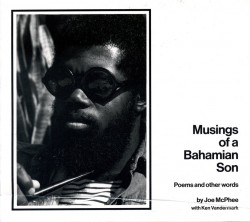 Another venerable musician, whose most recent CD is almost completely lyrical is upstate New York’s Joe McPhee, 83. He is someone who has proven his prowess on the soprano and tenor saxophones and pocket trumpet over the years in settings ranging from large ensembles to solo. Sometimes he also raps or recites poetry and on Musings of a Bahamian Son (Corbett vs Dempsey CvD CD 109 corbettvsdempsey.com/records) he verbalizes 28 of these lyrics as well as playing soprano saxophone on nine instrumental interludes backed by Ken Vandermark’s clarinet or bass clarinet. The disc ends with a profound free-form duet between McPhee and Vandermark and each interlude is distinctive, expressing moods ranging from a tough march tempo to poetic harmonies with Vandermark’s spiky snorts and caustic slurs nicely contrasting with McPhee’s vibrating trills and horizontal connections. Although a vocalized piece like The Grand Marquis with its couplet about “wearing the blues like a Mona Lisa smile” sets up the subsequent bluesy improvisation, most tracks focus on the prose and poetry. The recitations mix absurdist humor (The Last Of The Late Great Finger-Wigglers); Edward Lear-like imagery (The Ship With Marigold Sails); sardonic couplets that harangue divisive politicians and fret about climate change; and even attack AI (“music comes from people not tape machines,” he states on Party Lights). McPhee’s musical experience means that his verses about jazz greats also go way beyond name checking. Tell Me How Long Has Trane Been Gone (for James Baldwin and John Coltrane) for instance cannily blends song titles and book titles to make its point, while The Loneliest Woman (for Ornette Coleman) is turned into a plaint for lost love with Lady Marmalade’s choruses sung pointedly among the melody. Musings of a Bahamian Son is no introduction for those who have never experienced McPhee’s music – there are literally about 100 discs on which to hear that – but it will fascinate both those who have followed his career so far as well as poetry fans.
Another venerable musician, whose most recent CD is almost completely lyrical is upstate New York’s Joe McPhee, 83. He is someone who has proven his prowess on the soprano and tenor saxophones and pocket trumpet over the years in settings ranging from large ensembles to solo. Sometimes he also raps or recites poetry and on Musings of a Bahamian Son (Corbett vs Dempsey CvD CD 109 corbettvsdempsey.com/records) he verbalizes 28 of these lyrics as well as playing soprano saxophone on nine instrumental interludes backed by Ken Vandermark’s clarinet or bass clarinet. The disc ends with a profound free-form duet between McPhee and Vandermark and each interlude is distinctive, expressing moods ranging from a tough march tempo to poetic harmonies with Vandermark’s spiky snorts and caustic slurs nicely contrasting with McPhee’s vibrating trills and horizontal connections. Although a vocalized piece like The Grand Marquis with its couplet about “wearing the blues like a Mona Lisa smile” sets up the subsequent bluesy improvisation, most tracks focus on the prose and poetry. The recitations mix absurdist humor (The Last Of The Late Great Finger-Wigglers); Edward Lear-like imagery (The Ship With Marigold Sails); sardonic couplets that harangue divisive politicians and fret about climate change; and even attack AI (“music comes from people not tape machines,” he states on Party Lights). McPhee’s musical experience means that his verses about jazz greats also go way beyond name checking. Tell Me How Long Has Trane Been Gone (for James Baldwin and John Coltrane) for instance cannily blends song titles and book titles to make its point, while The Loneliest Woman (for Ornette Coleman) is turned into a plaint for lost love with Lady Marmalade’s choruses sung pointedly among the melody. Musings of a Bahamian Son is no introduction for those who have never experienced McPhee’s music – there are literally about 100 discs on which to hear that – but it will fascinate both those who have followed his career so far as well as poetry fans.
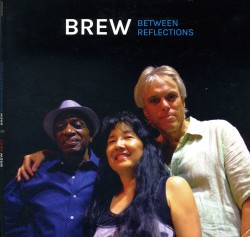 Oldest of these improv masters is American bassist Reggie Workman, 87, best-known for his 1960s tenures in John Coltrane’s quartet and the Jazz Messengers. But like the others cited here he’s still accepting new challenges more than a half century later. Heat/Between Reflections (Clean Feed CF 642 CD cleanfeed-records.com/product/heat-1998-99-between-reflections-2019-2cd-set) is a two-CD set of the Brew trio, consisting of the bassist, percussionist Gerry Hemingway and koto player Miya Masaoka, both of whom are two decades younger than Workman. Although the admixture may seem odd, there’s no fissure. As a matter of fact, when the others add implements like a monochord, vibes and electronics to their playing, Workman expands the textures on From Above and Below for example by using his expertise playing musical saw to answer the koto’s reflective patterns and drum rattles before reverting to a powerful bass line. Although it’s his responsive, but understated pulse that keeps the tunes horizontal, his strings can also create high-pitched violin-like sounds to top off Masaoka’s multi-string strums (on Morning) or complement with mid-range pops and scrapes from high-register koto twangs to harp like glissandi (on Between Reflections). Additionally Hemingway’s vibraphone sustain on One for Walt Dickerson is given more of a ripened sound when the bassist surrounds it with low-pitched arco swells. Overall, Workman’s positioned throbs are so forceful that the pace and direction of tracks never deviate even on those featuring jagged koto-string stabs, lug-loosening and cymbal rubbing beats and additional whistles and hisses from electronic programming.
Oldest of these improv masters is American bassist Reggie Workman, 87, best-known for his 1960s tenures in John Coltrane’s quartet and the Jazz Messengers. But like the others cited here he’s still accepting new challenges more than a half century later. Heat/Between Reflections (Clean Feed CF 642 CD cleanfeed-records.com/product/heat-1998-99-between-reflections-2019-2cd-set) is a two-CD set of the Brew trio, consisting of the bassist, percussionist Gerry Hemingway and koto player Miya Masaoka, both of whom are two decades younger than Workman. Although the admixture may seem odd, there’s no fissure. As a matter of fact, when the others add implements like a monochord, vibes and electronics to their playing, Workman expands the textures on From Above and Below for example by using his expertise playing musical saw to answer the koto’s reflective patterns and drum rattles before reverting to a powerful bass line. Although it’s his responsive, but understated pulse that keeps the tunes horizontal, his strings can also create high-pitched violin-like sounds to top off Masaoka’s multi-string strums (on Morning) or complement with mid-range pops and scrapes from high-register koto twangs to harp like glissandi (on Between Reflections). Additionally Hemingway’s vibraphone sustain on One for Walt Dickerson is given more of a ripened sound when the bassist surrounds it with low-pitched arco swells. Overall, Workman’s positioned throbs are so forceful that the pace and direction of tracks never deviate even on those featuring jagged koto-string stabs, lug-loosening and cymbal rubbing beats and additional whistles and hisses from electronic programming.
Like politicians, not all musicians ripen and mature with advancing age. However, the musicians here, in their late seventies and eighties certainly make the case for lifetime inspiration and performance.
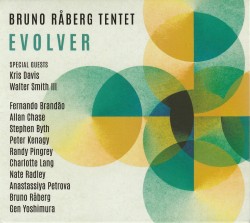 Evolver
Evolver

